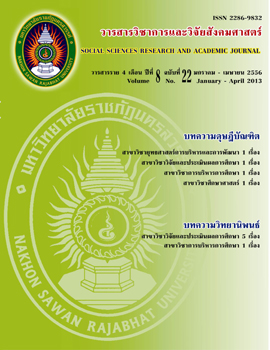การสร้างแบบวัดทักษะการคิดคำนวณ สำหรับนักเรียนชั้นประถมศึกษาปีที่ 6 ในจังหวัดนครสวรรค์
Main Article Content
Abstract
บทคัดย่อ
การวิจัยครั้งนี้มีวัตถุประสงค์ เพื่อสร้างและตรวจสอบคุณภาพแบบวัดทักษะการคิดคำนวณสำหรับนักเรียนชั้นประถมศึกษาปีที่ 6 ในจังหวัดนครสวรรค์ และเพื่อสร้างเกณฑ์ปกติในรูปตำแหน่งเปอร์เซ็นไทล์และคะแนนมาตรฐานสเตไนน์ กลุ่มตัวอย่างเป็นนักเรียนชั้นประถมศึกษาปีที่ 6 สังกัดสำนักงานเขตพื้นที่การศึกษานครสวรรค์ ได้มาโดยการสุ่มแบบแบ่งชั้น จำนวน 782 คน เครื่องมือที่ใช้ในการวิจัยเป็นแบบวัดทักษะการคิดคำนวณ แบบเลือกตอบ 4 ตัวเลือก จำนวน 60 ข้อ มีค่าความยากเท่ากับ 0.36-0.80 ค่าอำนาจจำแนกเท่ากับ 0.21 - 0.76 และค่าสัมประสิทธิ์ความเที่ยงเท่ากับ .87 วิเคราะห์ข้อมูลโดยใช้สถิติพื้นฐาน และการวิเคราะห์องค์ประกอบเชิงยืนยันอันดับสอง ผลการวิจัยพบว่า
1. แบบวัดทักษะการคิดคำนวณ มีลักษณะเป็นแบบเลือกตอบ 4 ตัวเลือก ประกอบด้วย ทักษะการบวก ทักษะการลบ ทักษะการคูณและทักษะการหาร ด้านละ 15 ข้อ รวม 60 ข้อ มีค่าความยากง่ายอยู่ระหว่าง 0.31-0.80 ค่าอำนาจจำแนกอยู่ระหว่าง 0.20 - 0.51และมีค่าความเที่ยงโดยการวิเคราะห์ความคงที่ภายใน ด้วยวิธี KR-20 เท่ากับ 0.92
2. แบบวัดมีค่าความตรงเชิงโครงสร้าง โดยการตรวจสอบด้วยวิธีวิเคราะห์องค์ประกอบเชิงยืนยันอันดับสอง พบว่า มีค่าไค-สแควร์ เท่ากับ 3578.47, p = 0.00 ที่องศาอิสระเท่ากับ 1656 และดัชนีวัดระดับความกลมกลืน (GFI) เท่ากับ .87 ดัชนีวัดระดับความกลมกลืนที่ปรับแก้แล้ว (AGFI) เท่ากับ .85 ดัชนีความสอดคล้องเปรียบเทียบ (CFI) เท่ากับ 0.97 ดัชนีรากของค่าเฉลี่ยกำลังสองของเศษเหลือ (RMR) เท่ากับ .013 ดัชนีรากกำลังสองเฉลี่ยของค่าความแตกต่างโดยประมาณ (RMSEA) เท่ากับ .039 ดัชนีรากของค่าเฉลี่ยกำลังสองของความคลาดเคลื่อนมาตรฐาน (SRMR) เท่ากับ .058
3. เกณฑ์ปกติของแบบวัดทักษะการคิดคำนวณ จำแนกเป็น 3 ระดับ ได้แก่ ระดับสูง คือ สเตไนน์ที่ 7-9 และมีตำแหน่งเปอร์เซนไทล์ที่ 77.01 ขึ้นไป ระดับปานกลาง คือ สเตไนน์ที่ 4-6 มีตำแหน่งเปอร์เซนไทล์ ตั้งแต่ 23.01 ถึง 77.00 และระดับต่ำ คือ สเตไนน์ที่ 1-3 มีตำแหน่งเปอร์เซนไทล์ น้อยกว่า 23.00
Abstract
The purpose of this research was to study construction of the calculation skills test for the Prathomsuksa 6 students in Nakhon Sawan province and to create a normal criterion of the percentile rank and standard stannine scores. The samples consist of 782 Pratomsuksa 6 students is under the area of Educational Office of Nakhon Sawan province obtained by stratified random sampling. The research tool was a calculation skills test modified into a 4-multiple-choice test of 60 items, with degree of difficulty of 0.36-0.80, discrimination power of 0.21-0.76, and reliability coefficient of 0.87. The data were analyzed using basic statistics and second order confirmatory factor analysis.
The finding were as follows:
1. Calculation skills test was a four-multiple-choice test, consisting of the addition skill, the subtraction skill, the multiplication skill and the division skill. Each skill has 15 items. Overall this test had 60 items, with degree of difficulty of 0.31-0.80, and discrimination power between .20-0.51. Its reliability coefficient after an analysis of internal consistency by using KR-20 method wes 0.92.
2. Construct validity by the second order confirmatory factor analysis found the chi–square (c2) of 3578.47; degree of freedom (df) of 1656, probability level (p) of 0.00, goodness of fit index (GFI) of .87, adjusted goodness of fit index (AGFI) of .85, comparative of fit index (CFI) of 0.97, root mean square residual (RMR) of .013, root mean square error of approximation (RMSEA) of .039, standardized RMR (SRMR) of .058.
3. Normal of the calculation skills test can classify students into 3 levels. The students with high level sufficiency economy traits are those of Stanine 7-9, with the Percentile above 77.01. The students with medium level sufficiency economy traits are those of Stanine 4-6, with the Percentile from 23.01 to 77.00. The students with low level sufficiency economy traits are those of Stanine 1-3, with the Percentile lower than 23.00.


